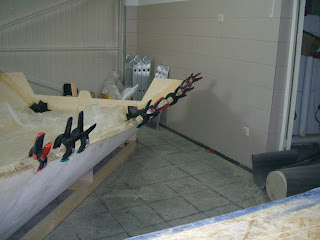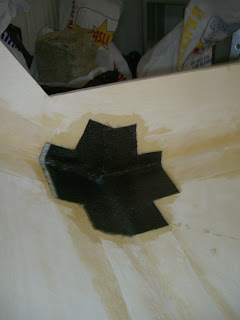İn a previous post İ described the method İ used to mark all frame location on the bottom hull. As a summary:
-draw a center line on your bottom hull from bow to transom
-pull a string across the length of your boat from bow to transom. Make sure this string is fixed at the same height at bow and transom. You want it to be paralel to the water line.
-mark all frame placement on this string
-use a plumb at each mark (İ use a thin string and a simple drop like fishing weight) on the string to indicate you the exact location on bottom hull panel
-draw a perpendicular line to the center line at each plumb mark.
You now know where to align the bottom of each frame.
To know where the side of the frames go, simply use your plumb again to level your frames straight. İf the bottom of the frame is on the hull line you drew and your frame is leveled straight, then the edges of your frames should be at the right location.
One issue İ had however is that some of my frame had a bit of warp and although the bottom was right on the money, the edges were not where they were supposed to. To correct this, İ used a simple long straight 1" x1"wood stick and clamped it to the top of the frame, across the hull width (from star to port) No more warp, frame edges pointing were they were supposed to.
Final check was using the Beckwith String Method, which is excellent. Just attach a string a the bow and measure the distance from bow to frame edge on one side. Keep the measurement and move to the other side pulling that string along with you. The frame's other end should be exactly at the same distance from bow.
Repeat the whole process a few time (bottom alignment,frame plumbed,Beckwith method) making smaller and smaller adjustments and in about 10-15 mns you have a pretty accurate position. Mark this position along the inside panels and on top of sheer clamp. Proceed with making all holes, pass the zip ties trough, tighten carefully and progressively making sure you have no hollows.
Voila !!! Frames are in place

On the left picture , if you look carefully, you will notice the center line drawn on the bottom panel, the main guide string running from bow to transom, and the little plumbs made of string and washers I have used to insure all frames were leveled at

their correct location .
Detail of of little plumb hanging down from main string. Everything seems to be pretty symetrical and well aligned.































.jpg)



.jpg)